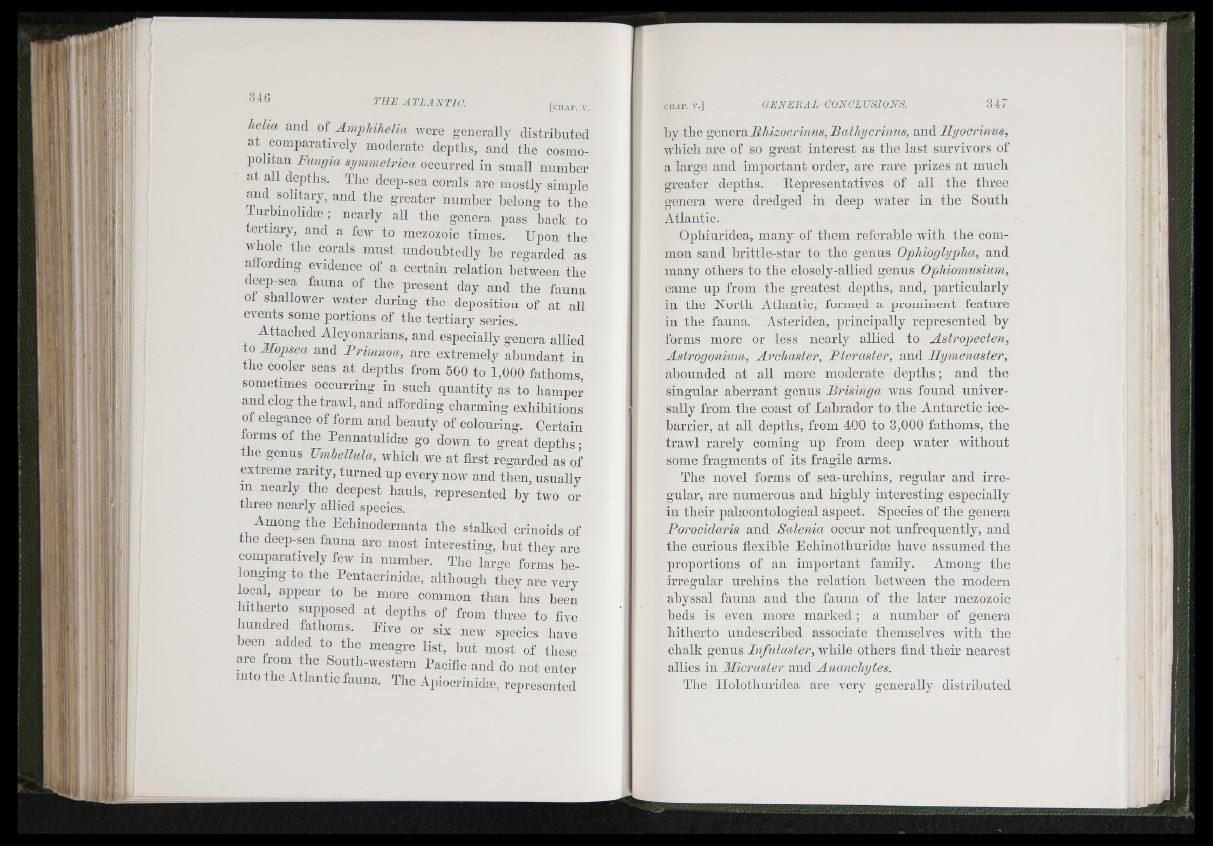
'
ri || ; ! 1 \\\[:
I r !' ■ -
helm and of Amplahelia Avere generally distributed
cat comparatively moderate depths, and tbe cosmopolitan
Fungia symnielrioa occurred in small number
at all depths. The deep-sea corals are mostly simple
and solitary, and tbe greater number belong to the
iir molida?; nearly all tbe genera pass back to
tertiary, and a fcAv to mezozoic times. Upon tbe
whole tbe corals must undoubtedly be regarded as
caffordmg evidence of a certain relation betAveen tbe
deep-sea fauna of tbe present day and tbe fauna
ot sballoAver water during the deposition of at all
events some portions of tbe tertia ry series.
Attached Alcyonarians, and especially genera allied
to Mopsea and Frlmuoa, are extremely abundant in
tJie cooler seas at depths from 500 to 1,000 fathoms
sometimes occurring in sucb quantity as to hamper
and clog the traAvl, and affording charming exhibitions
of elegance of form and beauty of colouring. Certain
forms of tbe Pennatulidm go down to great depths ■
the genus Umbellula, Avbicb we at first regarded as of
extreme rarity, turned up every now and then, usuallv
111 nearly the deepest hauls, represented by two or
three nearly allied species.
Among tbe Ecbinodermata tbe stalked crinoids of
tbe deep-sea fauna are most interesting, but tbey are
comimratively few in number. Tbe large forms be-
ongmg to tbe Pentacrinidae, although they are very
ocal, appear to be more common tban has been
ntberto supposed at depths of from three to five
luiidred fathoms. Pive or six new species have
been added to tbe meagre list, but most of tbese
aie from the South-western Pacific and do not enter
into tbe xVtlaiitic fiiuna. The Apiocrinidm, represented
by tbe s;eneva.Bhizocrinus, Balhyolnus, and Ilyocrinus,
Avbicli are of so great interest as tbe last survivors of
a large and important order, are rare prizes at much
greater depths. Representatives of all the three
genera Avere dredged in deep Avater in the South
Atlantic.
Ophiuridea, many of them referable with the common
sand brittle-star to the genus Ophioglypha, and
many others to the closely-allied genns Ophiomusium,
came up from the greatest depths, and, particularly
in the North Atlantic, formed a prominent feature
in the fauna. Asteridea, principally represented by
forms more or less nearly allied to Aslropeclen,
Astrogoni'um, Archaster, Bteraster, and Ilymenaster,
abounded at all more moderate depths; and the
singular aberrant genus Brisinga was found universally
from the coast of Labrador to the Antarctic ice-
harrier, at all depths, from 400 to 3,000 fathoms, the
traAA'l rarely coming up from deep water without
some fragments of its fragile arms.
The novel forms of sea-urchins, regular and irregular,
are numerous and highly interesting especially
in their palaeontological aspect. Species of the genera
Porocidaris and Salenia occur not unfrequently, and
the curious fiexible Echinotlmridse have assumed the
proportions of an important family. Among the
irregular urchins the relation betAveen the modern
abyssal fauna and the fauna of the later mezozoic
beds is even more marked; a number of genera
hitherto undescribed associate tbeniselves AA'itb tbe
chalk genus Infulaster, while others find their nearest
allies in Micraster and Ananchytes.
The Holothuridea are very generally distributed